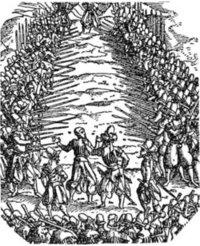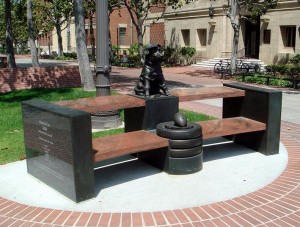??? (The Qingming Festival)
The Qingming Festival, which when translated literally means the Clear and Bright Festival, is a Chinese festival which is marked by a time of remembrance of ancestors. Occurring on the 104th day after the Winter Solstice, it usually falls around April 5th on the Gregorian calendar. On this day Chinese families will go out and clean the grave sites of their deceased relatives. They will also frequently burn sacrifices to their ancestors. Common items used are fake money or incense. Food is often left by the grave as well.
My grandfather Stone Chen explained the basics of this festival to me when I asked him about traditional Chinese customs. Called the Qingming Festival, this is the day which is dedicated to a familys ancestors. Qingming is translated as clear and bright; while my grandfather is not sure, he speculates that it is related to both the idea of the physical clearing of the graves as well as the psychological refreshing of past memories that one experiences during the course of the day. It is an all day occasion; the family usually starts by eating a brunch which is either cooked or held at a restaurant. If it takes place at a restaurant, it is usually Dim Sum. Dim Sum is a unique dining experience where one sits at a table and grabs food from passing carts. Each cart has a variety of different dishes and prices. That the end of the meal, an attendant totals up the empty plate and presents the diners with a bill. In any case, whether the meal is cooked at home or in a restaurant, a little extra portion is taken for each ancestor. For example, if the family is only attending to one grave, they will take food from the meal to the grave equivalent to about what one person would eat. The idea is that by taking food for the deceased relative, one remembers him and makes a conscious decision to include his spirit in their lives. This remembrance is most important. One of the most powerful images I have ever witnessed was the sight of my ninety-three year old paternal grandfather walking nearly a mile to Vons grocery market. Knowing that we were going to clean his wifes grave the coming day, he woke up at six and began the long trek to Vons to buy a can of 7UP, which was my grandmothers favorite drink. Though the hike took him three hours, we eventually found him at Vons and returned with him and his 7UP.
When the family arrives at the cemetery, they begin cleaning. This usually includes cutting the grass around the grave, cleaning and polishing the headstone, and doing whatever other maintenance is needed. Chinese graves are nearly always the cleanest around because of their frequent cleanings, which take place throughout the year, though this is the primary day of remembrance. The meal the family has packed for the ancestor is laid out before the grave and fragrant incense sticks are lit. In a way similar to how Western families leave flowers, Chinese leave gifts of food and incense. My grandfather explained that obviously they [the ancestors] cant eat it [the food] or smell it [the incense]; its just its just that these are nice things. Its a sign of our remembrance and respect. Often fake paper money is burned in a metal bowl, with idea that they deceased person will be able to use in to become wealthy in the afterlife. While my grandfather did not believe in this practice, he simply replied, If they want to, if it helps them feel better, whats the harm?
Every ritual on this day is both practical and symbolic. The graves need to be cleaned, and at least by dedicated Chinese families, they are quite frequently. However, this festival serves as a day where the ancestors are assured of remembrance and respect. Nearly every family will go out to the cemetery on this day. The food, incense, and money are all visible tokens of the familys remembrance of the deceased ancestor.
As I am increasingly seeing with my maternal grandfather, he is not particular about the specifics of this custom. He does not recollect the origins of this festival, but noted that it was a generally accepted holiday in both China and Taiwan. The festival is as old as he can remember. He is also not particular that we practice this festival on the correct day. It is enough for him if we merely practice it sometime; to him it is not the tradition or rules of the festival in particular which is important. The thought, that moment of remembrance and respect, is what is most critical. Without the right attitude, he says, you can do all these things and what is it really? Nothing. Ultimately it is the thought, rather than the rule and ritual, which truly matters.




